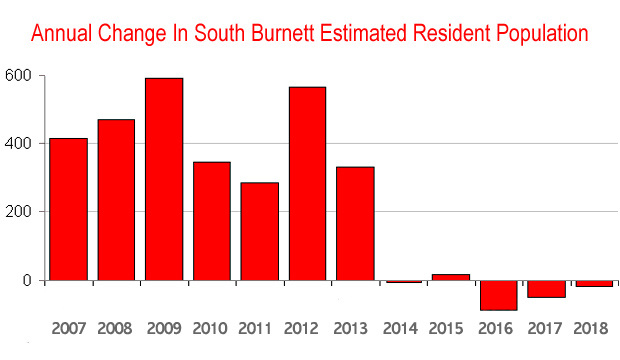
April 10, 2019
by Dafyd Martindale
The South Burnett’s population has dropped to its lowest level since 2013, according to new data from the Australian Bureau of Statistics (ABS).
In recently released figures, the ABS reported the region’s estimated population at June 30, 2018, was 32,555.
This was a drop of 19 people compared with the same period a year earlier.
It was also the fourth population decline the region has seen in the past five years.
The last time the South Burnett’s population came close to the current figure was June 30, 2013 (32,699).
The latest figures are also below the anticipated 33,759 to 36,164 population the State Government was forecasting for the region in 2009.
The Queensland Government Statistician’s Office now projects the region’s population will not exceed its 2009 low-end estimate until June 30, 2026 (34,170) and its high-end estimate until 2036 (36,342).
However, this is based on the assumption the trend of the past five years can be reversed.
Since 2013, the South Burnett has experienced average annual negative growth of -0.1 per cent.
The Statistician’s Office’s latest projections are based on the assumption future average annual growth occurs at a rate of 0.6 per cent per year, slightly less than half the growth rate the region enjoyed from 2000 to 2013.
The usual causes of a declining population are fewer births than deaths, and/or an excess of emigration over immigration (ie more people leave than arrive).
Population decline is important because it affects regional economies.
For example, councils do not have a growing base of ratepayers across which to spread costs, so the impact of rate rises on individual households steadily gets greater over time.
Local businesses also have fewer customers to sell to, which in turn limits their ability to create jobs and, in some cases, can force them to close their doors.
Real estate prices can also stagnate or deflate, because there are more sellers than buyers in the market.
And since many State and Federal government services are funded based on population, a declining population can lead to cutbacks in government funding and fewer services.
One positive benefit of a declining population, though, is a drop in unemployment rates.
Studies show while declining populations tend to see the proportion of elderly residents increase, they also usually produce labour shortages, which helps reduce joblessness.
- Related article: Fewer People Call South Burnett Home























